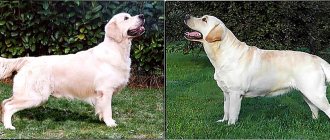For people considering getting a large, friendly dog, it is important to know the difference between a Golden Retriever and a Labrador. These breeds, at first glance, are quite similar. They can be distinguished by certain features of their body structure and temperament.
It is possible to distinguish a representative of one type of retriever from another at an early age. The most important thing is to know what characteristics of the pet to pay attention to, and ask the breeder for the dog’s pedigree to eliminate any mistakes.
Origin of rocks
Both types of dogs belong to the group of retrievers. However, they are two different types that were bred under different conditions. They had a huge influence on the formation of the characteristics of dogs, including their character:
- The Labrador Retriever was bred in Newfoundland and from there brought to England. Its ancestors are considered to be Indian dogs, and there is also an opinion that this breed is related to Newfoundlands (which is partially documented). Fishermen kept similar dogs. They used their pets for various purposes: they pulled backgammon, nets, and brought caught fish. This lifestyle made the representatives of this breed active, hardy and quite obedient.
- Golden Retrievers were developed in England. They were intended for hunting - they brought shot game to their owner without damaging its carcass. Since representatives of this breed had to run through forests and swamps at any time of the year, they developed a dense coat that made it easy to withstand adverse weather conditions. Such dogs lived in a calmer environment, and therefore never showed the increased activity inherent in their brothers. When breeding Goldens, special attention was paid to the color of the pet's coat, since it was also a kind of decoration. Due to their aristocratic origins, Goldens turned out to be more refined in appearance, soft in character, and adapted to living in small apartments.
Initially, the presented breeds were bred to perform various tasks. This shaped the character of such pets, their need for physical labor, as well as their ability to get along with people.
Story
Great Britain is considered the birthplace of dogs. But their purpose was different. The Golden Retriever was bred to hunt birds. Labrador was brought from the island of Newfoundland. He became an assistant for fishermen (he pulled fish out of snares). His ancestors are considered to be “divers” - large dogs from Canada.
The name of this breed is translated from Portuguese as “hard worker.”
Scottish Lord Tweedmouth received Golden Retrievers (crossing setters and Russian pointers). He spent a lot of time getting the dogs' coats evenly golden. He needed them to be clearly visible among forest vegetation and swamps when hunting.
Expert opinion
Anna Abramenko
An avid dog lover. Experience in veterinary medicine since 2009.
Ask a Question
Retrievers and Labradors are often contrasted, calling this pair “aristocrat-craftsman.”
Difference in breed standards
The presented types of dogs differ from each other in a number of parameters. Among them:
- Coat type. Labradors have short, no more than 5 cm, straight hair covered with a waxy coating. This allows your pet to swim in cold water and not catch a cold. Goldens have longer hair that is slightly curly.
- Color. Labradors can be black, chocolate or fawn. As for the retriever, it can only be golden in color (coat shades may differ among representatives of the American, Canadian and European breeds).
- Tail. In goldens it is lush and oblong. Labradors have a straight and strong coat, with a denser coat of hair.
- Body type. Goldens are always lighter and more graceful. Representatives of the second breed, due to their shorter hair, have a stockier, heavier body, although they do not weigh more than their close relatives.
In other respects, the dogs differ little, which is why they are often confused. Thus, adult male Labradors reach 63 cm at the withers, and their weight is 40 kilograms. Retrievers grow up to 61 centimeters, 41.5 kilograms. Similar ratios in proportions are also typical for females.
Please note: if this is not a purebred individual, but a mixed breed of one of the presented breeds, it may not meet the standard of its species. To avoid buying such a puppy, always carefully study the dog’s pedigree before purchasing.
As for similar characteristics for the presented animal species, these include:
- Proportion of the head to the body, wide forehead.
- Scissor bite.
- The so-called “soft mouth” - pets can move a fragile thing from place to place without damaging it.
- Drop ears.
According to the sign, it is not possible to distinguish one type of retriever from another. Because of this, puppies of the presented breeds are often confused by inexperienced dog breeders.
Difference between Golden Retriever and Labrador
- Origin. The Labrador is of rural blood, and the retriever is of noble blood.
- Wool. Short and straight in one breed, long soft and silky in another.
- Tail. It often stands like a pistol for a rural worker, has different thicknesses at the base and at the end, is almost always lowered for a British aristocrat, and is simply an extension of the body.
- Application. The Labrador is used to move loads, as a guide and nanny; the retriever's destiny is hunting and sports.
- Character. Puppy-like and cheerful in one of the breeds, prim and reserved in the other.
Do pets have different personalities?
If it is not so easy to distinguish a Labrador from a retriever by external signs, then by character this can be done easily. Dogs have a number of differences:
- Activity level. Retrievers are traditionally calmer, they need less games and training, which is why such dogs take root well in apartments. Labradors, on the other hand, need constant high physical activity, active walks, and long games in the fresh air.
- Sensitivity to changes in the owner's mood. Retrievers are considered more sensitive dogs. They better understand the mood of their master. Thanks to this quality, they are often taken for people with problems with physical and mental development.
- Reactions to the command. Labradors carry out orders received immediately and with great enthusiasm. Goldens need time to consider their owner's instructions. They may execute a command in a non-standard way if they decide it would be better that way. This behavior is not a sign of disobedience - it indicates the pet's high cognitive abilities.
- Relationships with others. Both types of dogs are very friendly. However, goldens are more likely to take root in large families - they are more careful with people, and are easier to train as “nannies” for autistic children, blind people, and older people due to their calmer temperament.
Both breeds always remain friendly. They rarely show aggression towards other animals or people. Therefore, such dogs are not suitable as guards or watchdogs.
So who's better
Every dog breeder wants to choose a good, promising breed. To the question “Who is better?” It’s difficult to answer definitively. Much depends on your lifestyle. The fact is that Labrador owners need to be prepared for daily vigorous walks, as the dogs are very athletic and active. Retrievers, on the other hand, prefer a more relaxed life, although even in this case they need to be walked often.
In general, both types of dogs can live in an apartment and have good contact with children. What’s interesting: very often, doctors strongly recommend that families who have children with mental retardation purchase golden retrievers or Labradors. With constant communication of a sick child with such dogs, his condition will soon noticeably improve.
Is there a difference in care and training?
The presented breeds require different approaches to conditions of maintenance and care:
- Retrievers can be housed in an apartment. Due to their temperament, Labradors will have to be placed in a private home. If this cannot be done, the owner needs to devote at least an hour a day to walking and playing with his own pet, otherwise he will literally destroy the house. Both types of dogs must live in the same room with the owner. Placing them in the yard in a booth or putting them on a chain is strictly prohibited.
- Retrievers are best suited for families with small children and older adults. Unlike their more active counterparts, they will never harm a person. Even in the heat of play they will not push him.
- Labradors require more careful grooming. Unlike goldens, they shed constantly. The owner needs to brush the pet regularly and bathe it often so that it does not develop parasites.
- Both breeds require regular walking. But if for certain reasons you cannot devote an hour of personal time every day to walks with your pet, you should opt for a retriever. He tolerates lack of physical activity more easily.
As for the nutritional rules, the list of mandatory vaccinations, and the range of skills that need to be taught to such dogs, they differ little. It is recommended that you check with your veterinarian on an individual basis so that you can provide your pet with the necessary care.
Behavioral features
Two types of dogs have been in great demand among dog breeders for many years. Both breeds can successfully serve humans as rescuers, guide dogs, bloodhounds, or even hunters. But retrievers have one significant advantage in this regard - they are not only capable of performing such tasks, but in addition they are very artistic.
Dogs are also easy to train.
Which breed is more obedient and easier to train?
The types of dogs presented are easy to train. Labradors and retrievers have approximately the same cognitive abilities, they are among the top ten domestic animals with the highest intelligence, and they easily learn various commands, including complex skills such as “Fetch” and “Voice.” Training of such individuals can begin from the age of two months. A person can easily cope with this task on his own. Only those dog breeders who have picked up an adult dog from the street may have some problems with its upbringing, which an experienced dog handler can solve.
To achieve success with puppies, the owner needs to take into account the temperament of the chosen breed. So, with Labradors, he will need to play more and conduct long training sessions, while calmer goldens will benefit from average physical activity and short but frequent exercises.
Video: How is a Labrador Retriever different from a Golden Retriever?
Content
It is necessary to strictly observe the feeding and walking regime for pets. A Labrador Retriever needs more exercise than a Retriever. Walks should be long (at least an hour) and include outdoor games and repetition of commands. You need to walk your dog several times a day. Without fast running, jumping, sports and other activities, the dog will be bored. Left alone in the apartment, he can spoil things. To prevent this from happening, you need to offer him some activities. It is best to buy toys for your dog (rubber balls and sticks, interactive toys). The owner can play sports with the Labrador. Suitable sports include canicross, agility, and flyball.
You also need to walk your golden for a long time and a lot. They also love active games and interesting toys, so you shouldn’t deprive them of this. Retrievers do not need dog sports.
Note! Despite their good health, both dogs are prone to many diseases. It is necessary to regularly take your pet for examination to the veterinary clinic and promptly treat any ailments.
Retrievers' ears are covered with long hair. The Labrador's entire body is covered with short hair.
What do you need to know when choosing a puppy so as not to be confused between these breeds?
To choose a pet from one of the presented species, you need to pay attention to the following features:
- Wool quality. Remember that the Labrador has short, straight, dense hair with a soft, dense undercoat. If you notice waves or feathering, it means you have a golden or mixed breed.
- Color of the dog. Remember that goldens do not come in a brown shade, much less black. The name of the breed indicates this feature. The only exceptions may be crossbreeds. However, in the future they will not demonstrate the necessary physical and mental characteristics inherent in purebred animals. You are more likely to buy a black or chocolate Labrador from a nursery.
- Tail elevation angle. In Goldens it forms a slight curve in relation to the body; in Labradors it usually rises above the line of the back. It's easy to check: play with your puppy. When in a good mood, these dogs actively wag their tail.
When you come to the nursery to pick up a future pet that is more than two months old, you can do a small test. Take any toy, show it to the baby, throw it forward a couple of meters and order him to bring it. The Labrador will rush after her as soon as he sees her. Golden will wait a while and only then go for the item.
Where is the “dog buried”?
First of all, let’s dwell on the meaning of the word “retriever” itself. Its English root contains the concepts of returning, finding, serving. Since it is used in the name of both species, it means that the “dog is buried” here, that is, the main common features are hidden. So, retrievers:
- bred to serve the hunter with downed or wounded game;
- have a strong athletic build with well-developed muscles;
- sufficiently strong jaws are used with caution, which keeps the prey in excellent condition;
- not suitable for guard duty;
- possess both remarkable strength and a good-natured, reserved disposition;
- feel passionate affection for the owner;
- tolerant of children's pranks;
- get along well with other pets;
- love water activities and are unsurpassed swimmers among other dog breeds;
- show extraordinary endurance;
- have a delicate sense of smell;
- thanks to excellent memory and intelligence, they are easy to train;
- distinguished by intelligence and ingenuity;
- They are considered “thinking” dogs.











